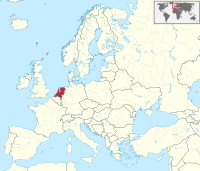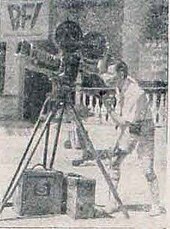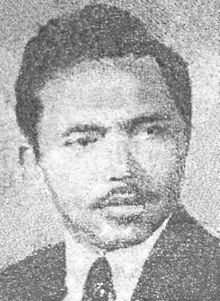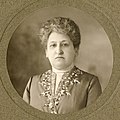Portal:Netherlands
Welcome to the Netherlands Portal
Welkom bij het Nederlandportaal!

|

|

| |
The Netherlands, informally Holland, is a country located in northwestern Europe with overseas territories in the Caribbean. It is the largest of the four constituent countries of the Kingdom of the Netherlands. The Netherlands consists of twelve provinces; it borders Germany to the east and Belgium to the south, with a North Sea coastline to the north and west. It shares maritime borders with the United Kingdom, Germany, and Belgium. The official language is Dutch, with West Frisian as a secondary official language in the province of Friesland. Dutch, English, and Papiamento are official in the Caribbean territories.
The Netherlands has been a parliamentary constitutional monarchy with a unitary structure since 1848. The country has a tradition of pillarisation (separation of citizens into groups by religion and political beliefs) and a long record of social tolerance, having legalised prostitution and euthanasia, along with maintaining a liberal drug policy. The Netherlands allowed women's suffrage in 1919 and was the first country to legalise same-sex marriage in 2001. Its mixed-market advanced economy has the eleventh-highest per capita income globally. The Hague holds the seat of the States General, Cabinet and Supreme Court. The Port of Rotterdam is the busiest in Europe. Schiphol is the busiest airport in the Netherlands, and the fourth busiest in Europe. Being a developed country, the Netherlands is a founding member of the European Union, Eurozone, G10, NATO, OECD, and WTO, as well as a part of the Schengen Area and the trilateral Benelux Union. It hosts intergovernmental organisations and international courts, many of which are in The Hague. (Full article...)
-
Jacobus Anthonie Meessen (Dutch pronunciation: [jaːˈkoːbʏs ɑnˈtoːni ˈmeːsə(n)]; 5 December 1836 – 14 November 1885) was a Dutch photographer who took more than 250 portraits and landscapes of the Dutch East Indies (now Indonesia) between 1864 and 1870. Born to a carpenter in Utrecht, Meessen worked in that trade in the Indies before marrying in the Netherlands in the early 1860s. He returned to the colony in 1864, intent on documenting its land and people. He worked mostly in the capital of Batavia (now Jakarta), Java, and Padang, Sumatra; he also photographed Bangka, Belitung, Borneo, and Nias.
When Meessen returned to the Netherlands in 1870, he established a short-lived partnership with Abraham Vermeulen and began disseminating his photographs. Selected images were given to King William III in an elaborately decorated album in 1871, while more were published by De Bussy in 1875 and exhibited in Paris and Amsterdam. In his final years, Meessen worked predominantly as an architect. Collections of his albumen prints, some of which were hand-tinted or annotated, are held in four institutions in the Netherlands. (Full article...) -
William III (William Henry; Dutch: Willem Hendrik; 4 November 1650 – 8 March 1702), also widely known as William of Orange, was the sovereign Prince of Orange from birth, Stadtholder of Holland, Zeeland, Utrecht, Guelders, and Overijssel in the Dutch Republic from the 1670s, and King of England, Ireland, and Scotland from 1689 until his death in 1702. As King of Scotland, he is known as William II. He ruled Britain and Ireland alongside his wife, Queen Mary II, and their joint reign is known as that of William and Mary.
William was the only child of William II, Prince of Orange, and Mary, Princess Royal, the daughter of King Charles I of England, Scotland, and Ireland. His father died a week before his birth, making William III the prince of Orange from birth. In 1677, he married his first cousin Mary, the eldest daughter of his maternal uncle James, Duke of York, the younger brother and later successor of King Charles II. (Full article...) -
Fakih Usman (alternatively spelled as Faqih Usman; [faˈkɪh ʊsˈman]; 2 March 1904 – 3 October 1968) was an Indonesian Islamic leader and politician of the Masyumi Party. He twice served as the Minister of Religious Affairs under the cabinets of Abdul Halim and Wilopo from January until September 1950, and again from 1952 until 1953. In his early years, Fakih was criticized by conservative Muslims for his involvement with the modernist Islamic Muhammadiyah organization, though he is remembered fondly by the group. Born to a merchant and his wife in Gresik, Dutch East Indies, Fakih studied with his father and at a series of pesantren (Islamic boarding schools) until the 1920s.
In 1925 he became involved with the Muhammadiyah, rising quickly through the leadership until he became the head of the Surabaya branch in 1938. He was also active in local politics, in 1937, he became the treasurer of the Indonesian Islamic Assembly. He continued to be involved in politics and Islamic groups during the Japanese occupation and the ensuing national revolution. Following the end of the war, he was appointed Minister of Religious Affairs. As a minister, he oversaw educational and institutional reform, growing in prominence within the Muhammadiyah. He also served as deputy chairman of the organization under several different leaders before being chosen as its chairman in late 1968. He died several days later. (Full article...) -
Djadoeg Djajakusuma ([dʒaˈdʊʔ dʒajakuˈsuma]; 1 August 1918 – 28 October 1987) was an Indonesian film director and promoter of traditional art forms. Born to a nobleman and his wife in Temanggung, Central Java, Djajakusuma became interested in the arts at a young age, choosing to pursue a career in theatre. During the Japanese occupation from 1943 to 1945 he was a translator and actor, and in the four-year national revolution which followed he worked for the military's educational division, several news agencies, and in drama.
In 1951, Djajakusuma joined the National Film Corporation (Perfini) at the invitation of Usmar Ismail. After making his directorial debut with Embun, Djajakusuma released a further eleven films with the company before leaving in 1964. He then returned to traditional Indonesian theatre, including wayang. Although he continued to direct movies independently of Perfini, most of his energies were dedicated to promoting traditional art forms and teaching cinematography. After over a decade of poor health and high blood pressure, Djajakusuma collapsed during a ceremony and died. He was buried in Karet Bivak Cemetery. (Full article...) -
Kedok Ketawa ([kəˈdɔʔ kəˈtawa]; Indonesian for The Laughing Mask, also known by the Dutch title Het Lachende Masker) is a 1940 action film from the Dutch East Indies (now Indonesia). Union Films' first production, it was directed by Jo An Djan. Starring Basoeki Resobowo, Fatimah, and Oedjang, the film follows a young couple who fight off criminals with the help of a masked man.
Advertised as an "Indonesian cocktail of violent actions ... and sweet romance", Kedok Ketawa received positive reviews, particularly for its cinematography. Following the success of the film, Union produced another six works before being shut down in early 1942 during the Japanese occupation. The film, screened until at least August 1944, may be lost. (Full article...) -

Union Films was a film production company located in Batavia, Dutch East Indies (now Jakarta, Indonesia). Established by ethnic Chinese businessmen Ang Hock Liem and Tjoa Ma Tjoen in 1940, it produced seven black-and-white films before it was dissolved in 1942; all are thought to be lost. The company's films were directed by four men, mostly ethnic Chinese, and launched the careers of actors such as Rendra Karno and Djoewariah.
Established during the revival of the Indies film industry, Union released its first film, Kedok Ketawa, in July 1940. This was followed by a series of films penned by Saeroen which were increasingly oriented towards the Indies' growing intelligentsia and attempted to distance themselves from the theatrical conventions which were common in the contemporary film industry. This continued after Saeroen left for Star Film in 1941, with Union's final two productions emphasising realism. Following the Japanese occupation of the Indies in March 1942, Union was dissolved, though its films continued to be screened into the mid 1940s. (Full article...) -
Akhmad Bassah (also Bassakh; [axˈmad baˈsax]; fl. 1923–30), best known by the pen name Joehana ([juˈhana]; Perfected Spelling: Yuhana), was an author from the Dutch East Indies who wrote in Sundanese. He worked for a time on the railroad before becoming an author by 1923, and had a strong interest in social welfare; this interest influenced his novels. He was also a productive translator, dramatist, and reporter, and operated a company which offered writing services. Sources disagree when Joehana died; some offer 1930, while others give 1942–45.
During the seven years in which he was active, Joehana wrote a number of stories and articles, as well as several novels. The years of publication are generally unclear, as reprints included neither the year of first publication nor the printing number. Stylistically, Joehana has been classified as a realist owing to his use of the names of actual locations and products in his works, as well as the predominantly vernacular Sundanese in his novels. However, influences from traditional theatrical forms such as wayang and literature such as pantun are evident. Joehana's works cover a wide range of themes, although in general they are oriented towards social criticism and promote modernization. (Full article...) -
Sair Tjerita Siti Akbari ([ʃaˈir tʃeˈrita siˈti akˈbari]; Perfected spelling: Syair Cerita Siti Akbari, Malay for Poem on the Story of Siti Akbari; also known as Siti Akbari) is an 1884 Malay-language syair (poem) by Lie Kim Hok. Adapted indirectly from the Sjair Abdoel Moeloek, it tells of a woman who passes as a man to free her husband from the Sultan of Hindustan, who had captured him in an assault on their kingdom.
Written over a period of several years and influenced by European literature, Siti Akbari differs from earlier syairs in its use of suspense and emphasis on prose rather than form. It also incorporates European realist views to expand upon the genre, although it maintains several of the hallmarks of traditional syairs. Critical views have emphasised various aspects of its story, finding in the work an increased empathy for women's thoughts and feelings, a call for a unifying language in the Dutch East Indies (now Indonesia), and a polemic regarding the relation between tradition and modernity. (Full article...) -
Soeara Berbisa ([suˈara bərˈbisa]; Perfected Spelling: Suara Berbisa; Indonesian for Venomous Voice) is a 1941 film from the Dutch East Indies. Produced by Ang Hock Liem for Union Films and directed by R Hu, this black-and-white film stars Raden Soekarno, Ratna Djoewita, Oedjang, and Soehaena. The story, written by Djojopranoto, follows two young men who compete for the affections of a woman before learning that they are long-lost brothers.
Filmed in September and October 1941, Soeara Berbisa features keroncong music and was shot partly in western Java. It was released to coincide with the Eid al-Fitr holiday and rated for all ages. Advertisements emphasised the film's appeal to both native and Dutch audiences, and a review in De Indische Courant was positive. Although the film—Union's penultimate production—was screened as late as 1949, it is now likely lost. (Full article...) -
Panggilan Darah (Indonesian for Call of Blood) is a 1941 film from the Dutch East Indies (now Indonesia) written and directed by Sutan Usman Karim and produced by Tjho Seng Han for Oriental Film. The black-and-white film starred Dhalia and Soerip as orphaned sisters trying to make a living in the colonial capital of Batavia (now Jakarta) before moving to Kudus to work at a clove cigarette factory.
Shot on location at an orphanage and two factories in central Java, Panggilan Darah was a modest commercial success in the Indies and Singapore. Its soundtrack, which featured nine kroncong songs, received popular acclaim, and the film's acting received critical praise. Despite this success, Oriental was unable to recoup its expenses, and merged into Multi Film soon afterwards. Panggilan Darah, which was screened as late as 1952, may now be lost. (Full article...)
-
Since 1 January 2023, there have been 342 regular municipalities (Dutch: gemeenten) and three special municipalities (bijzondere gemeenten) in the Netherlands. The latter is the status of three of the six island territories that make up the Dutch Caribbean. Municipalities are the second-level administrative division, or public bodies (openbare lichamen), in the Netherlands and are subdivisions of their respective provinces. Their duties are delegated to them by the central government and they are ruled by a municipal council that is elected every four years. Municipal mergers have reduced the total number of municipalities by two-thirds since the first official boundaries were created in the mid 19th century. Municipalities themselves are informally subdivided into districts and neighbourhoods for administrative and statistical purposes.
These municipalities come in a wide range of sizes, Westervoort is the smallest with a land area of 7.01 km2 (2.71 sq mi) and Súdwest-Fryslân the largest with a land area of 522.7 km2 (201.8 sq mi). Schiermonnikoog is both the least populated, with 982 people, and the least densely populated municipality at 23/km2 (60/sq mi). Amsterdam has the highest population with 918,117 residents as of January 2023, whereas The Hague is the most densely populated with a density of 6,827/km2 (17,680/sq mi). (Full article...) -

Film poster for Loetoeng Kasaroeng, the first locally produced film released in the Dutch East Indies
A total of 112 fictional films are known to have been produced in the Dutch East Indies (modern-day Indonesia) between 1926 and the colony's dissolution in 1949. The earliest motion pictures, imported from abroad, were shown in late 1900, and by the early 1920s imported serials and fictional films were being shown, often with localised names. Dutch companies were also producing documentary films about the Indies to be shown in the Netherlands. The first reports of fictional film production in the Indies date from 1923, although the work in question was not completed. The first locally produced film, Loetoeng Kasaroeng, was directed by L. Heuveldorp and released on 31 December 1926.
Between 1926 and 1933 numerous other local productions were released. Although Dutchmen like Heuveldorp and G. Krugers continued to be active in the industry, the majority of filmmakers and producers were ethnic Chinese. The Tan brothers (Khoen Yauw and Khoen Hian) and The Teng Chun were major producers during this period, while the Wong brothers (Nelson, Othniel, and Joshua) were among the more prominent directors. During the mid-1930s, production dropped as a result of the Great Depression. The release of Albert Balink's commercially and critically successful Terang Boelan (Full Moon) in 1937 led to renewed interest in filmmaking, and 1941 saw thirty locally produced films. This rate of production declined after the Japanese occupation beginning in early 1942, closing all but one film studio; this resulted in several films which had begun production in 1941 being released several years later. The majority of films produced during the occupation were short propaganda pieces. Following the Proclamation of Indonesian Independence in 1945 and during the ensuing revolution several films were made, by both pro-Dutch and pro-Indonesian backers; the Dutch formally recognised Indonesia's sovereignty on 27 December 1949, leaving the Dutch East Indies defunct. (Full article...) -
Twenty-two people are recorded as having produced fictional films in the Dutch East Indies between 1926, when L. Heuveldorp released Loetoeng Kasaroeng, the colony's first domestically produced film, and 1949, when the Dutch formally recognised Indonesia's sovereignty after a four-year revolution, leaving the Dutch East Indies defunct. Altogether, they are credited for 93 of all known films produced in the Indies, and four of them remained active after independence. All were men; the first female film producer in Indonesia, Ratna Asmara, produced her first film in 1953.
The colony's first producer, Heuveldorp, was of European descent. He was followed in 1928 by the ethnic Chinese businessmen Tjan Tjoen Lian and Liem Goan Lian, who began work on Lily van Java but soon pulled out, to be replaced by David Wong. By 1930 Chinese producers had dominated the industry. The most active of these, The Teng Chun, made his debut in 1931 with Boenga Roos dari Tjikembang; he would go on to produce another 27 films before independence. No native Indonesian film producers are recorded from this period, although several productions were credited only to companies. (Full article...) -
The Amsterdam Tournament (Dutch: Amsterdam Toernooi) was a pre-season association football competition, held in Amsterdam, Netherlands. The competition was hosted by Eredivisie club Ajax at the Amsterdam Arena. It was inaugurated in 1975 as the Amsterdam 700 Tournament to celebrate 700 years of history in the city. It was held annually each summer until 1992, when the last edition of the original tournament was played. It returned in 1999 with the backing of the International Event Partnership (IEP). Four teams participate in the competition, played in a league format since 1986.
Since its return, the tournament has used an unusual point scoring system. As with most league competitions, three points are awarded for a win, one for a draw and zero for a loss. An additional point, however, is awarded for each goal scored. The system is designed to reward teams that adopt a more attacking style of play. Each entrant plays two matches, with the winner being the club that finishes at the top of the table. The original competition was held at Amsterdam's Olympic Stadium, where Ajax played its international games until 1996. The Amsterdam Arena, now named the Johan Cruyff Arena, has played host to the event since the return until 2009. (Full article...) -

The Battle of Camperdown, painted by Philip de Loutherbourg in 1799.
The Battle of Camperdown was an important naval action of the French Revolutionary Wars, fought off Camperduin on the North Holland coast on 11 October 1797 between a British fleet under Admiral Adam Duncan and a Dutch fleet under Vice-Admiral Jan de Winter. The French Republic had overrun the Dutch Republic two years earlier, reforming it into the Batavian Republic. In early 1797, the Batavian Navy was ordered to sail to Brest and unite with the French Atlantic Fleet in preparation for an invasion of Ireland. Shortly afterwards, the British fleets were paralysed by the Spithead and Nore mutinies, in which the sailors refused to take their ships to sea until they were awarded better pay and conditions. For two months[citation needed], the English Channel was undefended, but the Dutch failed to take the opportunity to sail from their harbour in the Texel: their preparations were not complete, and a small squadron of loyal British ships under Duncan convinced de Winter that the British fleet was at sea by sending nonsensical signals to fictitious ships over the horizon.
By October 1797, the plan to attack Ireland had been abandoned and the British North Sea Fleet was again at full strength. During a brief period replenishing supplies at Yarmouth, news reached Duncan on 10 October that the Dutch had sailed on a raiding cruise[citation needed] and he returned to the Dutch coast, intercepting de Winter's fleet on its way back to the Texel. The Dutch formed a line of battle in shallow coastal waters to meet Duncan's attack, which was conducted in a confused mass, the British fleet separating into two groups that struck the vanguard and rear of the Dutch fleet, overwhelming each in turn and capturing eleven ships, including de Winter's flagship Vrijheid. On the return journey, three of the captured ships were lost, and none of the surviving Dutch prizes was ever suitable for active service again[citation needed]. Both sides suffered heavy casualties during the battle as each fleet had been trained to aim at the hulls of their opponents, maximising the damage to personnel. (Full article...) -

The Wong brothers (one pictured) were the first ethnic Chinese directors in the Indies.
Twenty-nine people are recorded as having directed fictional films in the Dutch East Indies between 1926, when L. Heuveldorp released Loetoeng Kasaroeng, the colony's first domestically produced film, and 1949, when the Dutch formally recognised Indonesia's sovereignty after a four-year revolution, leaving the Dutch East Indies defunct. Thirteen directors active in the Indies continued to direct films after 1950, including Usmar Ismail: his 1950 film Darah dan Doa (The Long March) is generally considered the first truly Indonesian film.
The colony's first directors, Heuveldorp and G. Kruger, were of European or mixed descent. They were followed by ethnic Chinese soon after, when Nelson Wong made his debut in 1928 with Lily van Java; other Chinese directors included Lie Tek Swie (1929), Wong's brothers Joshua and Othniel (1930), and The Teng Chun (1931). Ethnic Chinese directors dominated the colony's cinema for the remainder of its existence. The first native director, Bachtiar Effendi, made his debut in 1932 with the talkie Njai Dasima; another native director would not appear until Andjar Asmara and Rd Ariffien made their debuts in 1940. (Full article...) -
This page is a list of films that received the Golden Film since its introduction in 2001 by the Netherlands Film Festival and the Netherlands Film Fund. In 2001 and 2002, films from the Netherlands received the award once they had sold 75,000 tickets. From 2003 to date, the Golden Film is awarded to films from the Netherlands once they have sold 100,000 tickets. This page shows, for both audience criteria, which films received the Golden Film and how soon they received it after their releases.
In the following tables, the 'year' column contains the years in which the films received the Golden Film, the '#' column contains the number of the Golden Film, the 'film title' column contains the titles of the receiving films, the 'film release' column contains the dates on which the films were first released in the cinemas, and the 'Golden Film' column contains the days when the Netherlands Film Festival and the Netherlands Film Fund announced that the receiving films reached the audience criterion of the Golden Film. (Full article...)
Selected biography
-
Image credit: Detroit Publishing Co.
Restoration by Massimo CatarinellaA ca. 1900 photochrom of the Singel, a canal in Amsterdam, the Netherlands, with the Munttoren tower in the background. The canal served as a moat around the city until 1585, when Amsterdam expanded beyond the Singel. It is now the innermost canal in Amsterdam's semicircular ring of canals. -
Photo credit: Massimo CatarinellaThe InterContinental Amstel Amsterdam is a five-star hotel in Amsterdam, Netherlands, on the east bank of the river Amstel. It opened in 1867 and was the first Grand Hotel in the country. The hotel underwent significant renovations in 1992 at a cost of 70 million guilders.
-
Banknotes: Bank of IndonesiaThe rupiah is the national currency of Indonesia. Introduced in 1946 by Indonesian nationalists fighting for independence, the currency replaced a version of the Netherlands Indies gulden which had been introduced during the Japanese occupation in World War II. In its early years the rupiah was used in conjunction with other currencies, including a new version of the gulden introduced by the Dutch. Since 1950, it has had a lengthy history of inflation and revaluation. As of August 2018[update]
'"`UNIQ--nowiki-00000018-QINU`"'
, the currency—which is issued and controlled by the Bank of Indonesia—is trading for more than 14,600 rupiah to the United States dollar.
This note, denominated 100,000 rupiah, is from a 2011 revision of an earlier series. It depicts Sukarno and Mohammad Hatta, respectively Indonesia's first president and vice-president, on its obverse, and the People's Consultative Assembly building on its reverse.
See other denominations: Rp 1,000, Rp 2,000, Rp 5,000, Rp 10,000, Rp 20,000, Rp 50,000 -
Painting: Jan Cornelisz VermeyenMary of Hungary (1505–1558) was queen of Hungary and Bohemia as the wife of King Louis II. After their short, childless marriage ended with Louis' death, Mary's brother Ferdinand I came to power and made her regent – and later governor – of the Netherlands. She created unity between the provinces and was an enthusiastic patron of literature, music, and hunting.
-
V-2 rocket attackPhoto credit: Ingeldew, T3c, U.S. ArmyThe smouldering body of a boy killed by a V-2 rocket attack on the main intersection in Antwerp, Belgium, November 27, 1944, on the main Allied supply line to the Netherlands. The V-2, one of the German Vergeltungswaffen, was the first ballistic missile and first man-made object to achieve sub-orbital spaceflight. Over 3,000 V-2s were launched as military rockets by the Wehrmacht against Allied targets in World War II.
-
Card: Government of Dutch Guiana; image courtesy of the National Numismatic CollectionCard money, printed on plain cardboard or playing cards, was issued from the 17th to the 19th century to supplement the supply of money in several countries and colonies.
This playing card from Dutch Guiana (now Suriname), dated 1801, has a face value of one guilder. In that colony, card money was first issued in 1761, initially backed by bills of exchange from the Netherlands; but later it was released unsecured, and inflation was an issue for much of the currency's lifetime, with the value fluctuating wildly until it was replaced with paper money in 1826 and formally discontinued two years later. -
Photograph credit: Max Büttinghausen; restored by Adam CuerdenAletta Jacobs (1854–1929) was a Dutch physician and women's suffrage activist. Jacobs strove throughout her life to change laws that limited women's access to equality, starting in 1883 with an unsuccessful court challenge and eventually achieving success 100 years ago today, on 18 September 1919, with the signing of a suffrage bill into law. She is also noted for founding the world's first birth control clinic, in 1882. As a child Jacobs yearned to become a doctor like her father and, despite existing barriers, she fought to gain entry to higher education and became the first woman officially to attend a Dutch university, and one of the first female physicians in the Netherlands. Providing medical services to women and children, she grew concerned over the health of working women, and although she continued to practice medicine until 1903, she increasingly turned her attention to activism with a view to improving women's lives. In addition to her suffrage work she led campaigns aimed at deregulating prostitution, improving women's working conditions, and promoting peace.
-
Engraving: UnknownThe Christmas Flood of 1717 was the most recent large flood in the northern Netherlands, caused by a northwesterly storm that hit the coast of the Netherlands, Germany and Scandinavia on Christmas night of 1717. Approximately 14,000 people drowned. Floodwaters reached the towns and cities of Groningen, Zwolle, Dokkum, Amsterdam, and Haarlem. Many villages were devastated in the west of Vlieland, behind the sea dykes in Groningen province, and elsewhere.
-
Banknotes: Bank of IndonesiaThe rupiah is the national currency of Indonesia. Introduced in 1946 by Indonesian nationalists fighting for independence, the currency replaced a version of the Netherlands Indies gulden which had been introduced during the Japanese occupation in World War II. In its early years the rupiah was used in conjunction with other currencies, including a new version of the gulden introduced by the Dutch. Since 1950, it has had a lengthy history of inflation and revaluation. As of August 2018[update]
'"`UNIQ--nowiki-00000019-QINU`"'
, the currency—which is issued and controlled by the Bank of Indonesia—is trading for more than 14,600 rupiah to the United States dollar.
This note, denominated 20,000 rupiah, is from a 2011 revision of an earlier series. It depicts Oto Iskandar di Nata, a National Hero of Indonesia, on its obverse, and Sundanese tea farmers on its reverse.
See other denominations: Rp 1,000, Rp 2,000, Rp 5,000, Rp 10,000, Rp 50,000, Rp 100,000 -
Painting: Gerard ter BorchThe 1648 ratification of the Peace of Münster, as painted the same year by Gerard ter Borch. With this treaty, which was reached after seven years of negotiations, Spain formally recognized the independence of the United Netherlands. The treaty contributed to the Peace of Westphalia, which ended both the Thirty Years' War and the Eighty Years' War.
-
Photograph credit: Dominicus Johannes BergsmaClitocybe nebularis, commonly known as the clouded agaric or the cloud funnel, is a common gilled fungus that grows both in conifer-dominated forests and broad-leaved woodland in Europe and North America. This C. nebularis mushroom was photographed growing among fallen beech leaves in Famberhorst nature reserve, the Netherlands.
-
Coin credit: Java Mint; photographed by Heritage AuctionsThe Jawi alphabet is an Arabic-based writing system used to write the Malay language and several other Southeast Asian languages. This photograph shows an 1803 Netherlands Indies gulden silver rupee coin, minted at the Java Mint in the Dutch East Indies, featuring Jawi script; the image of the reverse (on the right) is inverted.
-
Photograph credit: Savyasachi, retouched by ukexpatLaura Dekker (born 1995) is a New Zealand–born Dutch sailor who completed a solo circumnavigation of the globe in a 12.4-metre (41-foot) two-masted ketch from 2010 to 2012. Dekker was fourteen years old when she set off from Gibraltar rather than the Netherlands, because the Dutch shipping regulations did not permit anyone under the age of sixteen to skipper a boat of that size in Dutch waters. After crossing the Atlantic Ocean, she started her record-breaking attempt from Sint Maarten in the Caribbean, passing through the Panama Canal and traversing the Pacific, Indian and Atlantic Oceans before completing her circumnavigation back at Sint Maarten. This picture shows Dekker attending the 2011 Hiswa Boat Show in Amsterdam.
-
Painting: Nicolaas PienemanJan Jacob Rochussen (1797–1871) was a Dutch politician who served as Governor-General of the Dutch East Indies and, later, Prime Minister of the Netherlands. Beginning his political career as a tax collector, Rochussen spent most of his life with an interest in finance and financial reform.
-
Photo: Murdockcrc
Did you know (auto-generated)

- ... that Isabella Correa was one of the few Jewish women poets active in the Netherlands before the 19th century?
- ... that the first recording of Bach's Kreuzstab cantata was a 1939 Dutch live broadcast sung by Mack Harrell, 25 years before the 1964 German recording by his protégé Barry McDaniel?
- ... that Semuel Jusof Warouw advocated Minahasan independence to gain leverage in Dutch–Indonesian negotiations?
- ... that about 700 airmen – and Ida Veldhuyzen van Zanten – have received the Dutch Airman's Cross?
- ... that Dutch designer Sabine Marcelis was a semi-professional snowboarder in New Zealand before she decided to pursue a career in the arts?
- ... that a former Dutch villa houses both the city council of Semarang, Indonesia, and the city's mayor?
Categories
Related portals
Featured content
Extended content
| ||
|---|---|---|
|
This page gives an overview of all featured content ( Featured articles
Featured lists
|
Things you can do

The Dutch Wikiportal is currently under construction. Help would be greatly appreciated!
See also:
Add yourself to the category of Wikipedians located in the Netherlands.
Wikiprojects

|
You are invited to participate in the WikiProject Netherlands, a WikiProject dedicated to developing and improving articles about the Netherlands. |

![Image 1 Jacobus Anthonie Meessen (Dutch pronunciation: [jaːˈkoːbʏs ɑnˈtoːni ˈmeːsə(n)]; 5 December 1836 – 14 November 1885) was a Dutch photographer who took more than 250 portraits and landscapes of the Dutch East Indies (now Indonesia) between 1864 and 1870. Born to a carpenter in Utrecht, Meessen worked in that trade in the Indies before marrying in the Netherlands in the early 1860s. He returned to the colony in 1864, intent on documenting its land and people. He worked mostly in the capital of Batavia (now Jakarta), Java, and Padang, Sumatra; he also photographed Bangka, Belitung, Borneo, and Nias. When Meessen returned to the Netherlands in 1870, he established a short-lived partnership with Abraham Vermeulen and began disseminating his photographs. Selected images were given to King William III in an elaborately decorated album in 1871, while more were published by De Bussy in 1875 and exhibited in Paris and Amsterdam. In his final years, Meessen worked predominantly as an architect. Collections of his albumen prints, some of which were hand-tinted or annotated, are held in four institutions in the Netherlands. (Full article...)](http://upload.wikimedia.org/wikipedia/en/d/d2/Blank.png)












![Image 3 Indonesian rupiah Banknotes: Bank of Indonesia The rupiah is the national currency of Indonesia. Introduced in 1946 by Indonesian nationalists fighting for independence, the currency replaced a version of the Netherlands Indies gulden which had been introduced during the Japanese occupation in World War II. In its early years the rupiah was used in conjunction with other currencies, including a new version of the gulden introduced by the Dutch. Since 1950, it has had a lengthy history of inflation and revaluation. As of August 2018[update] '"`UNIQ--nowiki-00000018-QINU`"' , the currency—which is issued and controlled by the Bank of Indonesia—is trading for more than 14,600 rupiah to the United States dollar. This note, denominated 100,000 rupiah, is from a 2011 revision of an earlier series. It depicts Sukarno and Mohammad Hatta, respectively Indonesia's first president and vice-president, on its obverse, and the People's Consultative Assembly building on its reverse. See other denominations: Rp 1,000, Rp 2,000, Rp 5,000, Rp 10,000, Rp 20,000, Rp 50,000 More selected pictures](http://upload.wikimedia.org/wikipedia/commons/thumb/2/2a/100000_rupiah_bill%2C_2011_revision_%282013_date%29%2C_processed%2C_obverse%2Breverse.jpg/120px-100000_rupiah_bill%2C_2011_revision_%282013_date%29%2C_processed%2C_obverse%2Breverse.jpg)





![Image 9 Indonesian rupiah Banknotes: Bank of Indonesia The rupiah is the national currency of Indonesia. Introduced in 1946 by Indonesian nationalists fighting for independence, the currency replaced a version of the Netherlands Indies gulden which had been introduced during the Japanese occupation in World War II. In its early years the rupiah was used in conjunction with other currencies, including a new version of the gulden introduced by the Dutch. Since 1950, it has had a lengthy history of inflation and revaluation. As of August 2018[update] '"`UNIQ--nowiki-00000019-QINU`"' , the currency—which is issued and controlled by the Bank of Indonesia—is trading for more than 14,600 rupiah to the United States dollar. This note, denominated 20,000 rupiah, is from a 2011 revision of an earlier series. It depicts Oto Iskandar di Nata, a National Hero of Indonesia, on its obverse, and Sundanese tea farmers on its reverse. See other denominations: Rp 1,000, Rp 2,000, Rp 5,000, Rp 10,000, Rp 50,000, Rp 100,000 More selected pictures](http://upload.wikimedia.org/wikipedia/commons/thumb/0/0c/20000_rupiah_bill%2C_2011_revision_%282013_date%29%2C_processed%2C_obverse%2Breverse.jpg/120px-20000_rupiah_bill%2C_2011_revision_%282013_date%29%2C_processed%2C_obverse%2Breverse.jpg)



































































































































































